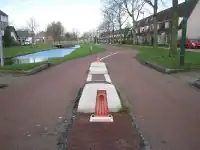Tag:barrier=sump_buster
 |
| Description |
|---|
| A barrier to stop cars (two tracked vehicles with less than a certain ground clearance and width between tracks). |
| Group: barriers |
| Used on these elements |
| Status: in use |
| Tools for this tag |
|
A sump buster is a low concrete slab or steel structure intended to stop passing of cars and other two tracked vehicles with less than a certain ground clearance and width between tracks. The vehicle will either be stopped by some low hanging part of the car hitting the block or by damaging the sump (oil pan) of the vehicle.
Ambulances, fire trucks, garbage trucks and other public service vehicles are often large enough to pass without problem.
Sometimes accompanied with signage that further restricts who can legally pass.
How to map
Simply add the tag barrier= to the node where it is located.
As always, do not place the barrier at a junction, but at a node on the branching way where the barrier actually is.
It is unspecified how to exactly map clearances. In practice, height=* gets used to specify the height of the object which, in the case of ground-based obstacles (such as sump busters), incidentally implies the ground clearance for vehicles wishing to pass over it. For sideway spacing, maxwidth:physical=* (as written in barrier=bollard) could be used. A few remaining nodes use non-standard mintrackwidth=* and/or manclearance=*.
Photos
-
 Sump buster on a cycleway (Schonenburgseind, Houten, The Netherlands).
Sump buster on a cycleway (Schonenburgseind, Houten, The Netherlands). -

-

-

-

Possible rendering
![]() suggested by User:Chrisana13
suggested by User:Chrisana13